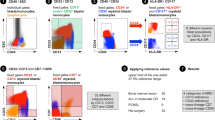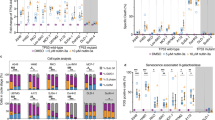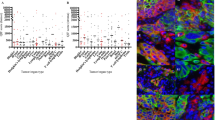Abstract
We describe here a protocol for the detection of epithelial cells in effusions combined with quantification of apoptosis by flow cytometry (FCM). The procedure described consists of the following stages: culturing and induction of apoptosis by staurosporine in control ovarian carcinoma cell lines (SKOV-3 and OVCAR-8); preparation of effusion specimens and cell lines for staining; staining of cancer cells in effusions and cell lines for cell surface markers (Ber-EP4, EpCAM and CD45) and intracellular/nuclear markers of apoptosis (cleaved caspase-3 and caspase-8, and incorporated deoxyuridine triphosphates); and FCM analysis of stained cell lines and effusions. This protocol identifies a specific cell population in cytologically heterogeneous clinical specimens and applies two methods to measure different aspects of apoptosis in the cell population of interest. The cleaved caspase and deoxyuridine triphosphate incorporation FCM assays are run in parallel and require (including sample preparation, staining, instrument adjustment and data acquisition) 8 h. The culturing of cell lines requires 2–3 days and induction of apoptosis requires 16 h.
This is a preview of subscription content, access via your institution
Access options
Subscribe to this journal
Receive 12 print issues and online access
$259.00 per year
only $21.58 per issue
Buy this article
- Purchase on Springer Link
- Instant access to full article PDF
Prices may be subject to local taxes which are calculated during checkout




Similar content being viewed by others
References
US-Canadian Consensus recommendations on the immunophenotypic analysis of hematologic neoplasia by flow cytometry. Bethesda, MD, USA, November 16–17, 1995. Cytometry 30, 213–274 (1997).
Orfao, A. et al. Clinically useful information provided by the flow immunophenotyping of hematological malignancies: current status and future directions. Clin. Chem. 45, 1708–1717 (1999).
Owens, M.A., Vall, H.G., Hurley, A.A. & Wormsley, S.B. Validation and quality control of immunophenotyping in clinical flow cytometry. J. Immunol. Methods 243, 33–50 (2000).
Dunphy, C.H. Applications of flow cytometry and immunohistochemistry to diagnostic hematopathology. Arch. Pathol. Lab. Med. 128, 1004–1022 (2004).
Bedrossian, C.W.M. Malignant effusions: A multimodal approach to cytologic diagnosis (Igaku-Shoin, New York, NY, 1994).
Davidson, B., Risberg, R., Reich, R. & Berner, A. Effusion cytology in ovarian cancer—new molecular methods as aids to diagnosis and prognosis. Clin. Lab. Med. 23, 729–754 (2003).
Chen, L.M., Lazcano, O., Katzmann, J.A., Kimlinger, T.K. & Li, C.Y. The role of conventional cytology, immunocytochemistry, and flow cytometric DNA ploidy in evaluation of body cavity fluids: a prospective study of 52 patients. Am. J. Clin. Pathol. 109, 712–721 (1998).
Schneller, J. et al. Flow cytometry and Feulgen cytophotometry in evaluation of effusions. Cancer 59, 1307–1313 (1987).
Unger, K.M., Raber, M., Bedrossian, C.W., Stein, D.A. & Barlogie, B. Analysis of pleural effusions using automated flow cytometry. Cancer 52, 873–877 (1983).
Krishan, A. et al. Detection of tumor cells in body cavity fluids by flow cytometric and immuncytochemical analysis. Diagn. Cytopathol. 34, 528–541 (2006).
Ceyhan, B.B., Demiralp, E. & Celikel, T. Analysis of pleural effusions using flow cytometry. Respiration 63, 17–24 (1996).
Sikora, J., Dworacki, G., Trybus, M., Batura-Gabryel, H. & Zeromski, J. Correlation between DNA content, expression of Ki-67 antigen of tumor cells and immunophenotype of lymphocytes from malignant pleural effusions. Tumour Biol. 19, 196–204 (1998).
Risberg, B., Davidson, B., Dong, H.P., Nesland, J.M. & Berner, A. Flow cytometric immunophenotyping of serous effusions and peritoneal washings: comparison with immunocytometry and morphological findings. J. Clin. Pathol. 53, 513–517 (2000).
Risberg, B. et al. Detection of monocyte/macrophage cell populations in effusions—a comparative study using flow cytometric immunophenotyping and immunocytochemistry. Diagn. Cytopathol. 25, 214–219 (2001).
Davidson, B. et al. Detection of malignant epithelial cells in effusions using flow cytometric immunophenotyping: an analysis of 92 cases. Am. J. Clin. Pathol. 118, 85–92 (2002).
Davidson, B. et al. αV- and β1-integrin subunits are commonly expressed in malignant effusions from ovarian carcinoma patients. Gynecol. Oncol. 90, 248–257 (2003).
Givant-Horwitz, V. et al. Expression of the 67kDa laminin receptor and the α6 integrin subunit in serous ovarian carcinoma. Clin. Exp. Metastasis 20, 599–609 (2003).
Davidson, B. et al. Altered expression of metastasis-associated and regulatory molecules in effusions from breast cancer patients: a novel model for tumor progression. Clin. Cancer Res. 10, 7335–7346 (2004).
Sigstad, E. et al. Quantitative analysis of integrin expression in effusions using flow cytometric immunophenotyping. Diagn. Cytopathol. 33, 321–331 (2005).
Kleinberg, L. et al. Expression of HLA-G in malignant mesothelioma and clinically aggressive breast carcinoma. Virchows Arch. 449, 31–39 (2006).
Dong, H.P. et al. NK and B cell infiltration correlates with worse outcome in metastatic ovarian carcinoma. Am. J. Clin. Pathol. 125, 451–458 (2006).
Dong, H.P. et al. Death receptor expression is associated with poor response to chemotherapy and shorter survival in metastatic ovarian carcinoma. Cancer 112, 84–93 (2008).
Vermeulen, K., Van bockstaele, D.R. & Berneman, Z.N. Apoptosis: mechanisms and relevance in cancer. Ann. Hematol. 84, 627–639 (2005).
Jin, Z. & El-Deiry, W.S. Overview of cell death signaling pathways. Cancer Biol. Ther. 4, 139–163 (2005).
Fadeel, B. & Orrenius, S. Apoptosis: a basic biological phenomenon with wide-ranging implications in human disease. J. Intern. Med. 258, 479–517 (2005).
Thompson, C.B. Apoptosis in the pathogenesis and treatment of disease. Science 267, 1456–1462 (1995).
Viktorsson, K., Lewensohn, R. & Zhivotovsky, B. Apoptotic pathways and therapy resistance in human malignancies. Avd. Cancer Res. 94, 143–196 (2005).
Johnstone, R.W., Ruefli, A.A. & Lowe, S.W. Apoptosis: a link between cancer genetics and chemotherapy. Cell 108, 153–164 (2002).
Wang, X. The expanding role of mitochondria in apoptosis. Genes Dev. 15, 2922–2933 (2001).
Fulda, S. & Debatin, K.M. Extrinsic versus intrinsic apoptosis pathways in anticancer chemotherapy. Oncogene 25, 4798–4811 (2006).
Darzynkiewicz, Z. et al. Cytometry in cell necrobiology: analysis of apoptosis and accidental cell death (necrosis). Cytometry 27, 1–20 (1997).
Vermes, I., Haanen, C. & Reutelingsperger, C. Flow cytometry of apoptotic cell death. J. Immunol. Methods 243, 167–190 (2000).
Ormerod, M.G., Paul, F., Cheetham, M. & Sun, X.M. Discrimination of apoptotic thymocytes by forward light scatter. Cytometry 21, 300–304 (1995).
Schmid, I., Uittenbogaart, C. & Jamieson, B.D. Live-cell assay for detection of apoptosis by dual-laser flow cytometry using Hoechst 33342 and 7-amino-actinomycin D. Nat. Protoc. 2, 187–190 (2007).
Riccardi, C. & Nicoletti, I. Analysis of apoptosis by propidium iodide staining and flow cytometry. Nat. Protoc. 1, 1458–1461 (2006).
Troiano, L. et al. Multiparametric analysis of cells with different mitochondrial membrane potential during apoptosis by polychromatic flow cytometry. Nat. Protoc. 2, 2719–2727 (2007).
Belloc, F. Flow cytometry detection of caspase 3 activation in preapoptotic leukemic cells. Cytometry 40, 151–160 (2000).
van Genderen, H. et al. In vitro measurement of cell death with the annexin A5 affinity assay. Nat. Protoc. 1, 363–367 (2006).
Gorczyca, W. et al. Induction of DNA strand breaks associated with apoptosis during treatment of leukemias. Leukemia 7, 659–670 (1993).
Darzynkiewicz, Z., Bedner, E. & Traganos, F. Difficulties and pitfalls in analysis of apoptosis. Methods Cell Biol. 63, 527–546 (2001).
Pozarowski, P., Grabarek, J. & Darzynkiewicz, Z. Flow cytometry of apoptosis. Curr. Protoc. Cell Biol. Chapter 18: Unit 18.8.1-18.8.33 (2004).
Komoriya, A., Packard, B.Z., Brown, M.J., Wu, M.L. & Henkart, P.A. Assessment of caspase activities in intact apoptotic thymocytes using cell-permeable fluorogenic caspase substrates. J. Exp. Med. 191, 1819–1828 (2000).
Bedner, E., Smolewski, P., Amstad, P. & Darzynkiewicz, Z. Activation of caspases measured in situ by binding of fluorochrome-labeled inhibitors of caspases (FLICA): correlation with DNA fragmentation. Exp. Cell Res. 259, 308–313 (2000).
Pozarowski, P., Huang, X., Halicka, D.H., Lee, B., Johnson, G. & Darzynkiewicz, Z. Interactions of fluorochrome-labeled caspase inhibitors with apoptotic cells: a caution in data interpretation. Cytometry A 55A, 50–60 (2003).
Ormerod, M.G., O'Neill, C.F., Robertson, D. & Harrap, K.R. Cisplatin induces apoptosis in a human ovarian carcinoma cell line without concomitant internucleosomal degradation of DNA. Exp Cell Res. 211, 231–237 (1994).
Oberhammer, F. et al. Apoptotic death in epithelial cells: cleavage of DNA to 300 and/or 50 kb fragments prior to or in the absence of internucleosomal fragmentation. EMBO J. 12, 3679–3684 (1993).
Belmokhtar, C.A., Hillion, J. & Ségal-Bendirdjian, E. Staurosporine induces apoptosis through both caspase-dependent and caspase-independent mechanisms. Oncogene 20, 3354–3362 (2001).
Gregory-Bass, R.C. et al. Prohibitin silencing reverses stabilization of mitochondrial integrity and chemoresistance in ovarian cancer cells by increasing their sensitivity to apoptosis. Int. J. Cancer 122, 1923–1930 (2008).
Ofir, R. et al. Taxol-induced apoptosis in human SKOV3 ovarian and MCF7 breast carcinoma cells is caspase-3 and caspase-9 independent. Cell Death Differ. 9, 636–642 (2002).
Davidson, B. et al. The role of Desmin and N-cadherin in effusion cytology: a comparative study using established markers of mesothelial and epithelial cells. Am. J. Surg. Pathol. 25, 1405–1412 (2001).
Dong, H.P., Holth, A., Berner, A., Davidson, B. & Risberg, B. Flow cytometric immunphenotyping of epithelial cancer cells in effusions - technical considerations and pitfalls. Cytometry B Clin. Cytom. 72B, 332–343 (2007).
Perfetto, S.P., Ambrozak, D., Nguyen, R., Chattopadhyay, P. & Roederer, M. Quality assurance for polychromatic flow cytometry. Nat. Protoc. 1, 1522–1530 (2006).
Schmid, I., Uittenbogaart, C.H. & Giorgi, J.V. Sensitive method for measuring apoptosis and cell surface phenotype in human thymocytes by flow cytometry. Cytometry 15, 12–20 (1994).
Schmid, I., Uittenbogaart, C.H., Keld, B. & Giorgi, J.V. A rapid method for measuring apoptosis and dual-color immunofluorescence by single laser flow cytometry. J. Immunol. Methods 170, 145–157 (1994).
Acknowledgements
This work was supported by the Norwegian Cancer Society, the Southern Norway Health Region Research Fund and the Research Fund at The Norwegian Radium Hospital.
Author information
Authors and Affiliations
Corresponding author
Rights and permissions
About this article
Cite this article
Dong, H., Kleinberg, L., Davidson, B. et al. Methods for simultaneous measurement of apoptosis and cell surface phenotype of epithelial cells in effusions by flow cytometry. Nat Protoc 3, 955–964 (2008). https://doi.org/10.1038/nprot.2008.77
Published:
Issue Date:
DOI: https://doi.org/10.1038/nprot.2008.77
This article is cited by
-
Upregulation of apoptotic protease activating factor-1 expression correlates with anti-tumor effect of taxane drug
Medical Oncology (2021)
-
Activated regulatory and memory T-cells accumulate in malignant ascites from ovarian carcinoma patients
Cancer Immunology, Immunotherapy (2015)
-
Detecting apoptosis of leukocytes in mouse lymph nodes
Nature Protocols (2014)
-
Nucleoside transporters are widely expressed in ovarian carcinoma effusions
Cancer Chemotherapy and Pharmacology (2012)
Comments
By submitting a comment you agree to abide by our Terms and Community Guidelines. If you find something abusive or that does not comply with our terms or guidelines please flag it as inappropriate.



